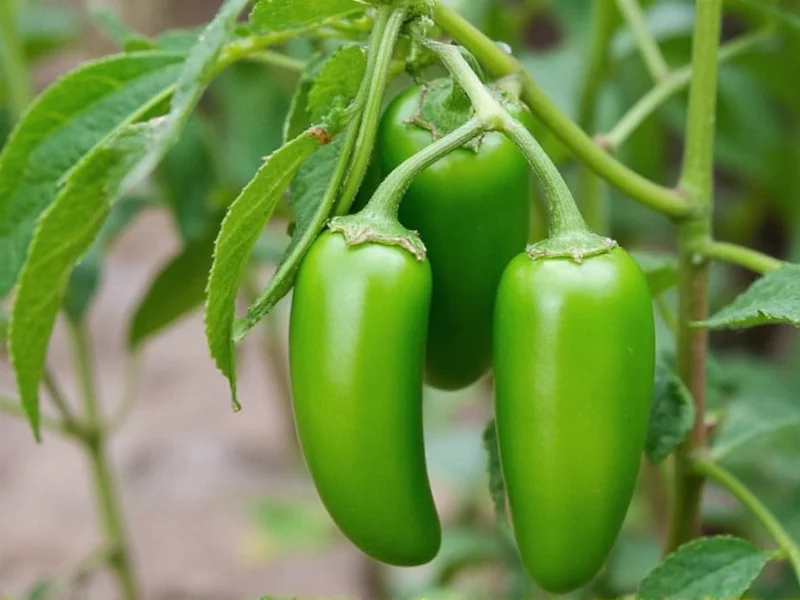Understanding exactly how hot is a jalapeño requires examining the Scoville scale, the measurement system for chili pepper heat. Developed by Wilbur Scoville in 1912, this scale measures capsaicin concentration—the compound responsible for spiciness—in Scoville Heat Units (SHU). While jalapeños sit comfortably in the mild-to-medium range, their heat profile has important nuances that affect culinary use.
The Science Behind Jalapeño Heat
Jalapeños (Capsicum annuum) contain capsaicinoids, primarily capsaicin and dihydrocapsaicin, which stimulate nerve receptors in your mouth. The concentration of these compounds determines the pepper's position on the Scoville scale. Unlike laboratory-tested pure capsaicin (16 million SHU), jalapeños offer a manageable heat that most palates can enjoy.
Several factors influence how hot are jalapeno peppers in your kitchen:
- Stress conditions: Peppers grown in less-than-ideal conditions (drought, temperature extremes) often develop higher capsaicin levels
- Ripeness: Red jalapeños (fully ripe) are typically hotter than green ones
- Seeds and ribs: The white pith and seeds contain most capsaicin—removing them reduces heat significantly
- Genetic variation: Different jalapeño cultivars have varying heat potentials
| Pepper Type | Scoville Heat Units (SHU) | Heat Level |
|---|---|---|
| Bell Pepper | 0 SHU | Mild |
| Jalapeño | 2,500-8,000 SHU | Mild-Medium |
| Serrano | 10,000-23,000 SHU | Medium-Hot |
| Habanero | 100,000-350,000 SHU | Very Hot |
| Ghost Pepper | 855,000-1,041,427 SHU | Extremely Hot |
Practical Implications for Cooks
Knowing the jalapeno scoville units range helps you anticipate how they'll perform in recipes. Most people can comfortably consume 1-2 jalapeños without significant discomfort, though sensitivity varies. When cooking with jalapeños:
- Wear gloves when handling to prevent capsaicin transfer to sensitive areas
- Remove seeds and white membranes for milder flavor
- Balance heat with dairy (yogurt, sour cream) or starches (rice, potatoes)
- Remember that cooking doesn't reduce capsaicin—it redistributes the heat
Why Heat Varies: Understanding Jalapeño Spiciness Factors
The question why are some jalapenos hotter than others has several scientific answers. Research from New Mexico State University's Chile Pepper Institute shows environmental stress directly impacts capsaicin production. When jalapeño plants experience:
- Water stress (drought conditions)
- Nutrient deficiencies
- Temperature fluctuations
- Pest or disease pressure
...they often produce more capsaicin as a defense mechanism. This explains why two jalapeños from the same plant might have noticeably different heat levels—a phenomenon known as factors affecting jalapeno spiciness.
Jalapeños in Culinary Context
Compared to other common peppers, jalapeños offer a sweet-heat balance that makes them kitchen staples. They're significantly milder than habaneros (about 20 times less hot) but noticeably spicier than poblano peppers. This jalapeno heat compared to other peppers positions them perfectly for dishes where you want discernible heat without overwhelming spice.
Professional chefs often use the float test to gauge jalapeño heat before cooking: hotter peppers tend to sink in water due to higher capsaicin density, while milder ones float. While not scientifically precise, this practical method helps manage jalapeno heat level for cooking in real-world kitchen scenarios.
Safety and Handling Tips
When working with particularly hot jalapeños, follow these safety guidelines for how to handle hot jalapenos:
- Always wash hands thoroughly after handling, especially before touching your face
- Use separate cutting boards for peppers to avoid cross-contamination
- Consider wearing food-safe gloves during preparation
- If experiencing burning sensation, use milk or yogurt—not water—to neutralize capsaicin
Common Misconceptions About Jalapeño Heat
Several myths persist about are jalapenos considered hot peppers. Contrary to popular belief:
- Size doesn't reliably indicate heat—small jalapeños can be milder or hotter than large ones
- Color alone doesn't determine heat level (though red jalapeños are often hotter)
- "Hotter" jalapeños aren't necessarily "better"—heat preference is subjective
- Removing seeds reduces but doesn't eliminate heat, as capsaicin permeates the flesh











 浙公网安备
33010002000092号
浙公网安备
33010002000092号 浙B2-20120091-4
浙B2-20120091-4